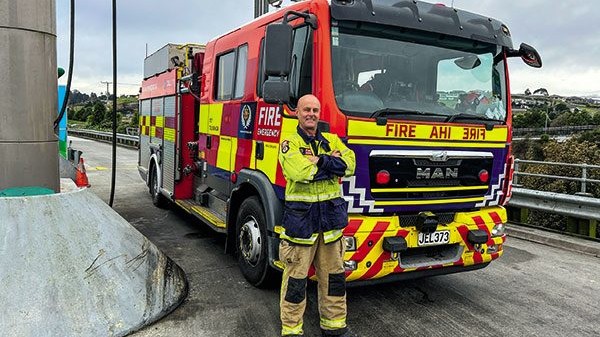Hamish Dalziell

Hamish Dalziell isn’t your typical truck driver. He can be found behind the wheel of Fire and Emergency New Zealand’s 290hp 2015 MAN TGM, responding with lights and sirens to fires, car accidents and medical calls.
Alison Verran spoke with Hamish at BP Tauriko, where he was fuelling up after a callout to a vehicle accident on Pyes Pa Road, Tauranga.
Hamish has been with the fire service for almost 20 years and driving trucks for 18 years. Not only has he driven fire trucks, but he also worked and drove for Treescape on his days off when living in Wellington.
As a firefighter, becoming an emergency response driver is a requirement. “We usually get our Class 2 within the first couple of years. We then go through emergency driver training. I had to drive around all different areas of Wellington, negotiating small, tight roads, as well as night driving. I also went to Ohakea Air Base to train for emergency braking, reactions in emergencies and to learn how to utilise the ESC (electronic stability control),” explains Hamish.
“After a few years of Class 2, some firefighters go on to get their Class 4 or 5 for the different types of ladder trucks that some stations have. We often have firefighters who are truck drivers on their days off. With the shifts we work it allows for a second job. In the service, we are allowed to do two shifts back-to-back. However, we can only drive the fire trucks on one of those shifts. Our day shift is a 10-hour day, and our night shift is 14 hours. If we do a double shift, we try and catch some sleep between emergencies.”
It’s clear that Hamish enjoys the driving part of the job. “Driving relatively quickly through the traffic enhances your skills and makes you very aware of the other vehicles around you. We are allowed to go 20km/h over the designated speed limit, apart from roadworks and past schools.”
One thing Hamish notices with other drivers is the lack of knowledge about pulling over for emergency vehicles. “On a road with a single lane each way, vehicles should always pull to the left. If there are two lanes each way, we would expect the vehicles to split left and right, and we will travel through the middle. Where we place our fire truck behind other vehicles determines the line we would like to take, indicating to those in front of us which way to pull over,” he explains.
“Tauranga roadworks are an issue at the moment. I feel sorry for the locals in cars when we come up behind them … they have nowhere to pull over. We turn off the sirens because we’re fully aware they are trying to move out of the way but simply can’t.
“We also have an issue in our industry – the fleet needs to be upgraded. If this truck breaks down, we get a 30-year-old truck as a stand-in.” According to Hamish and his colleagues, the horsepower in their trucks could definitely benefit from an upgrade too.
When presented with the vexing question, “rugby or soccer?”, Hamish answers: “Rugby … I’ve played ever since I was young. Although I do enjoy social soccer. I played a bit in Wellington.”
Read more
Ben Josephs
0 Comments1 Minutes
Neil Chiswell
0 Comments2 Minutes
Tony McCall
0 Comments3 Minutes
Workaholic Western Star
0 Comments3 Minutes






